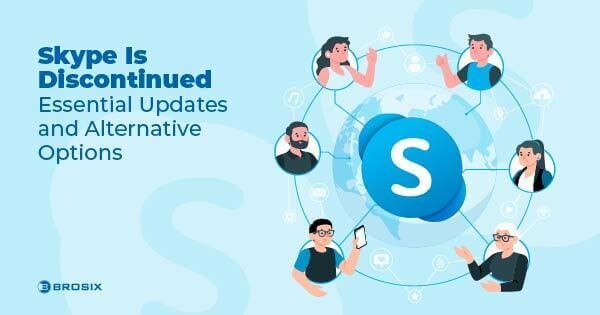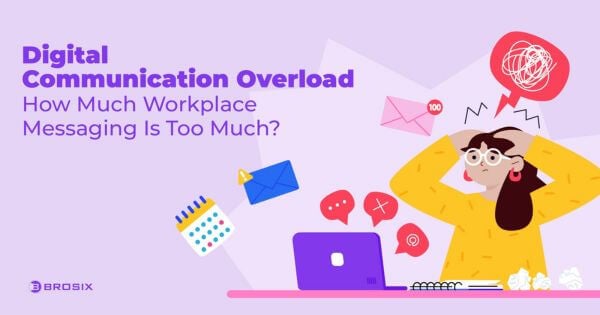Instant messaging (IM) is so deeply rooted in our daily lives that we rarely give it a second thought.
How did it come about? What is the engine behind it? Are there unique IM features we know nothing about? What is the mission of the instant messengers all around us?
In this article, I will answer these and other questions about instant messaging. Stay with me, because I will reveal interesting facts and in-depth knowledge.
What Is Instant Messaging?
Instant messaging (IM) is a form of written communication between two or more individuals in real time. Typically, text is transmitted via internet-connected devices.
Brief history and evolution of instant messaging
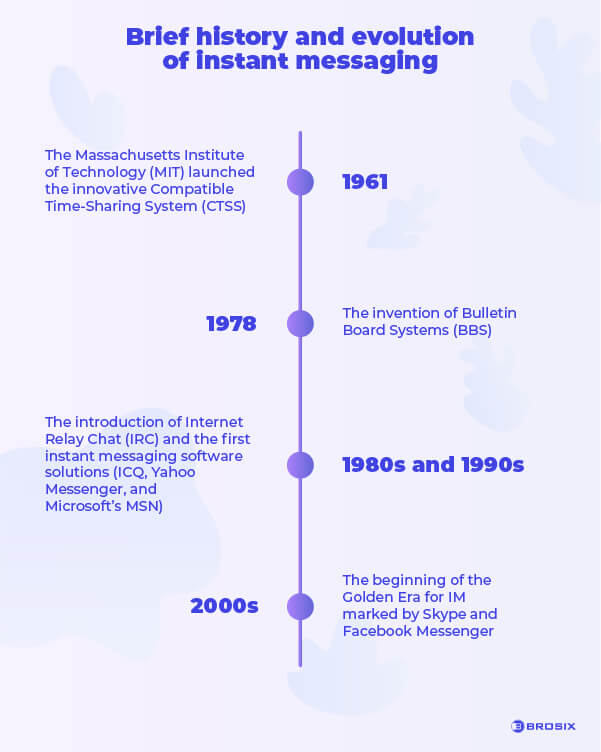
Believe it or not, instant messaging has been around since the 1960s.
In 1961, the Massachusetts Institute of Technology’s (MIT’s) innovative Compatible Time-Sharing System (CTSS) let up to 30 individuals log in and contact one another. The early beginnings of IM also included the invention of Bulletin Board Systems (BBS) in 1978. This enabled users to interchange messages and files through public message boards.
The rise of instant messaging came in the 1980s and 1990s with the introduction of Internet Relay Chat (IRC) and the first instant messaging software solutions. The emergence of Skype and Facebook Messenger in the 2000s marked the beginning of the Golden Era for IM.
In the past, instant messaging was mostly about text-based messages. Modern IM systems—created from 2010 until now—are feature-rich. They support a wide range of multimedia, including images, videos, voice messages, and more. This helps users to express themselves more fully and teams to coordinate tasks and share resources.
Instant messaging pioneers
ICQ, launched in 1996 by the Israeli company Mirabilis, is often credited as one of the pioneers of modern instant messaging. Then, in 1998, ICQ was acquired by America Online, the company behind AOL Instant Messenger. The latter once dominated the instant messaging market in North America.
Yahoo Messenger and Microsoft’s MSN are also notable instances of instant messengers that helped popularize instant messaging in the 1990s.
Differences between instant messaging and other forms of communication
Comparing instant messaging with other forms of online communication, it becomes clear that they differ in many ways.
Let’s first talk about email vs IM.
Email is suited to asynchronous communication. You can send a message and receive a reply, regardless of whether your correspondent is online at the same time or not. On the other hand, instant messaging allows for synchronous communication between the sender and the recipient.
SMS does that, too. Decoding the dilemma of instant messaging vs text messaging, SMS holds significant disadvantages like a character limit and fees that must be paid to your phone service provider. Unlike IM, SMS doesn’t allow for sending media or files.
The conclusion is obvious: instant messaging is a top choice for anyone who wants to rapidly communicate and exchange information in various file formats.
How Instant Messaging Works
In this section, I’ll discuss the technical aspects of instant messaging, its undeniable advantages, as well as the main features typical of IM tools. Let’s keep going.
How to use instant messaging
Getting started with instant messaging is as simple as pie.
You have to download the IM client to your computer or mobile device, such as a tablet, Android, or iOS smartphone. Many IM tools can be accessed on the web as well.
Once you have created your username and password, you can log in and start adding contacts to your list. Before signing in, however, you might have to enter an email address and verify your account by clicking on a link sent to you after registration.
All in all, this sums up everything on the front end. Let’s peek at the backend now.
Instant messaging protocols
On the technical side of instant messaging, different protocols and technologies run behind the scenes. Most high-level messaging apps and tools, including Brosix, rely on proprietary protocols that are inaccessible to third parties.
In a nutshell, these are three of the most common protocols used in the instant messaging industry:
- IRC (Internet Relay Chat): This is one of the oldest chat protocols that’s still relevant today. It’s reliable for text-based communication in online communities. The most prominent example is the mIRC client.
- WebRTC (Web Real-Time Communication): It’s known for its open-source nature and strong audio capabilities, making it suitable for browser-based communication. Examples include Google Meet and Discord.
- SIP/SIMPLE (Session Initiation Protocol): This protocol focuses on initiating and maintaining communication sessions, supporting presence and basic messaging. Skype is a well-known example of an app that uses SIP.
Types of instant messaging
To make the picture clearer for you, I have to mention the key types of instant messaging available: server-based and peer-to-peer (P2P). Check out the main differences between both of them:
- Server-based: As the name suggests, when users sign up, they connect to a centralized server. Only after that can they communicate with each other.
- Peer-to-peer: P2P technology enables direct user contact free from a central server. This means that when you text somebody, your device connects directly to theirs.
In summary, server-based IM relies on a central hub for message delivery, while P2P eliminates the need for it, potentially enhancing privacy.
Features and functionalities
Every IM app has its own competitive advantage. However, most instant messengers come with a certain set of standard and advanced features. I’ll cover them below.
Core features
Two main functions characterize IM as such:
- Real-time text communication: Messages are sent and received immediately, in a matter of seconds.
- Presence indicators: You can easily check the availability of anyone on your buddy list, or whether they are currently online or offline.
Advanced features
These are testaments to the evolution of instant messaging throughout the years—from simple text exchange to much more advanced features:
- File sharing: Sharing files with coworkers, clients, or prospects has become part of everyday life for many professionals. Using an instant messaging app with unlimited file transfer capabilities is a must.
- Voice and video calls: Video and voice chat are valuable tools for remote communication when face-to-face meetings are not feasible.
- Group chats: Group chats offer a private, secure online platform for groups of people to hold private and confidential discussions.
- Screen sharing: It is ideal for remote environments where coworkers may not have the opportunity to sit together.
- Broadcast messages: Broadcast messaging allows you to send updates to a large group of people simultaneously, with no option for replies or feedback. This helps to avoid unnecessary clutter or message threads.
Security and privacy
Recognizing the need for high-level security, both personal and enterprise instant messengers are working actively toward meeting customer expectations.
However, most business IM tools offer a safe forum for corporate communication by default. They usually provide their clients with:
- Closed networks
- End-to-end encryption
- Peer-to-peer communication channels
- Antivirus integration
- Compliance with industry standards, such as HIPAA
- Other specific data security levels
All this enables businesses of all kinds to avoid becoming victims of the next data or privacy breach.
Users’ data is also protected by features such as two-factor authentication, secure login, and privacy settings.
Benefits of Instant Messaging
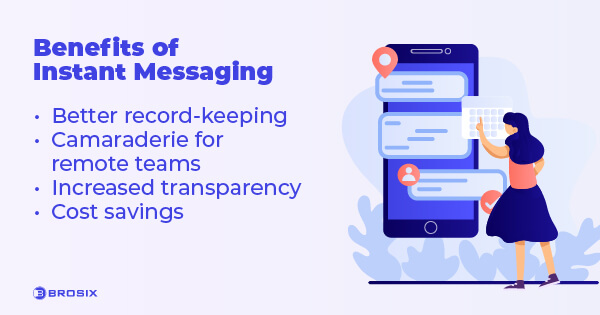
Besides the quick interactions between users and the useful features of IM tools, there are many benefits of instant messaging for businesses that are worth noting:
- Better record-keeping: Internal communication records can enhance performance by providing a chronicle of conversations, enabling easy recall, and identifying productive times and collaborative flows.
- Camaraderie for remote teams: Instant messaging can improve job happiness and productivity by encouraging camaraderie. Video chats and group chat rooms let team cohesiveness grow by helping to discuss personal events and small victories.
- Increased transparency: Using IM tools is fairly simple and doesn’t require having a technical background. Task updates, resolving issues, and overall project management become easier for everyone.
- Cost savings: When choosing an IM tool, price plays a vital role. Fortunately, there are many options on the market that won’t break the bank. It’s even possible to get a whole palette of features with an all-in-one messaging tool at an affordable price.
Examples of Instant Messaging
Now that we’ve gone through the theoretical part, and you are well aware of what instant messaging is, let me give you a few concrete examples. I have curated these all with precision, so I can show you only the top of the top.
Popular instant messaging platforms
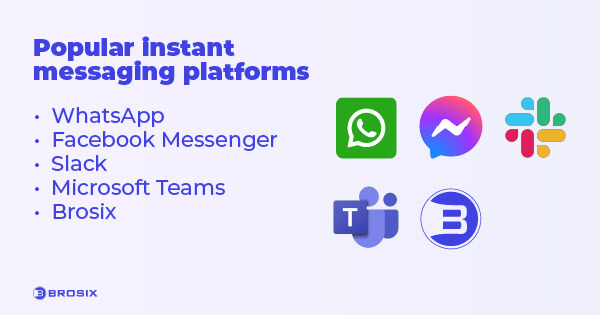
Ever since the emergence of mIRC and ICQ, I think everyone has valued the role of instant messaging a lot in their daily lives. Did you know that ICQ recently shut down for good? It was a fairly good IM application until its last days.
However, there are many still-operational instant messaging apps that deserve your attention.
No surprises here—only worldwide famous names.
- WhatsApp: It’s mostly preferred for personal communication, although it has a version aimed at businesses.
- Facebook Messenger: Closely tied to Meta (Facebook)—a social media platform that’s known to many—Messenger is the go-to instant messaging tool for lots of individuals and companies.
- Slack: This instant messaging application is designed to bring professional teams together. It features various functions such as channels, integration, and file sharing.
- Microsoft Teams: The successor to Skype for Business. It provides its users with basic and advanced features, including chat, file storage, and video conferencing.
- Brosix: It’s aimed at facilitating communication in professional environments. Brosix stands out as an IM service, offering a host of collaboration tools and it makes no compromises in terms of security.
Instant messaging examples in different contexts
When choosing an instant messenger, the most important thing is to keep in mind what exactly you need it for. There are three main contexts in which you can use instant messaging:
- Personal: It’s mostly about staying in touch with friends and family, sharing daily updates, and coordinating your joint plans.
- Business: Instant messaging holds tremendous potential to facilitate team collaboration, and project management, and accelerate decision-making.
- Educational: Synchronous instant communication between students and teachers supports remote learning.
Case study: Brosix and Solaris Medical Supplies
With the rise of remote work, it’s safe to say that IM has penetrated various industries, from tech and finance to retail, healthcare, and more. Many companies worldwide have switched to instant messaging, so they can keep business communication going without interruption and delays and, therefore, collaborate more effectively.
Here at Brosix Instant Messenger, we see firsthand the positive impact of the responsible use of IM. One example is our experience with Solaris Medical Supplies. Being highly secure and HIPAA compliant, we managed to provide this organization with an internal IM system that suits their team well.
Their team is distributed in four different states in the USA. Yet, with Brosix, effective communication and keeping sensitive personal data safe don’t pose a challenge.
Common Abbreviations and Jargon in Instant Messaging
As with any other type of communication, there are particular rules and etiquette to follow in IM, too.
Two of these rules are essential: Keep your messages brief and to the point, and use emojis sparingly when it comes to IM at work. Let me tell you more.
Popular abbreviations
Sometimes I am in such a hurry to get all sorts of tasks done that writing long messages may seem like something that hinders my productivity. Are you familiar with this feeling, too?
Rather, IM is designed to support productivity and time optimization. Sending messages and files is immediate, as is receiving them from the other side. And for fast typing, there are many abbreviations. Here are the most popular ones in the world of IM:
- AKA: Also known as
- B4: Before
- BRB: Be right back
- FYI: For your information
- HBD: Happy birthday
- IDK: I don’t know
- IMO: In my opinion
- LOL: Laugh out loud
- PIC: Picture
- SPIM: Spam over instant messaging
- THX: Thanks
- W8: Wait
Surely you know and have used some of them. Now you can take advantage of the rest.
Emojis and symbols
Emoticons diversify and refresh text-based communication as they can express tone and emotions better than words can. In this regard, IM users are generally divided into two camps: for and against emojis at work.
For Gen Z and millennials, using emojis is normal. But keep in mind that older colleagues might not approve of using emojis at work. They might perceive it as unprofessional behavior.
Examples and meanings of popular emojis:
- ?: Happiness or friendliness
- ?: Sadness or disappointment
- ?: Approval or agreement
- ?: Idea or suggestion
The Future of Instant Messaging
Today, we are on the verge of a technological revolution. With the advent of machine learning and natural language processing (NLP), almost nothing is the same as it was 10 years ago, for example. Instant messaging is no exception.
Trends and innovations
The main trends in instant messaging are the use of chatbots and artificial intelligence (AI).
The main goal of chatbots in IM is to provide automated customer service and support around the clock. Chatbots can also be used for educational purposes, such as providing answers to common questions or providing interactive tutorials.
Last but not least, chatbots can act as virtual assistants to help automate mundane tasks, such as collecting customer data for enhanced decision-making or approving orders.
As for AI, many instant messengers today introduce AI-driven features, among which are predictive text and personalized responses, making IM more intuitive and efficient.
Challenges and considerations
Although I can’t deny the great convenience instant messaging brings to the table, I must address some risks and drawbacks. Here’s what to pay attention to:
- Misinformation and fake news: With chat rooms full of people, it’s now more than easy to send a link to a news story and have it spread like wildfire. Yes, many people have critical thinking and will check the source, but many will not.
- Cyberbullying and harassment: Instant messaging platforms with low moderation provide an online space for ill-intentioned people to send inappropriate messages and even threats. Having clear policies in place helps prevent such problems.
- Distraction and overload: Constant push notifications coming from instant messengers can influence the productivity of some teammates. That’s why companies should encourage employees to set boundaries.
- Security and privacy risks: Sensitive information shared through messaging apps could be vulnerable to data breaches, leaks, and cyber threats. It’s recommended not to share such details on apps for personal use. If used in a work setting, the IM app should meet the highest security and privacy standards.
Conclusion
Instant messaging is an important tool for connecting people in real time. Its usefulness can’t be underestimated, as it makes it possible for users to communicate and share files in the blink of an eye.
The influence of instant messaging on both personal and professional communication is not expected to decrease; on the contrary. With all the diverse messaging services and features already going much further than just texting, we’re witnessing an evolution that will continue in the future.





